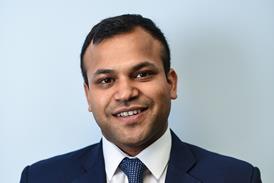With a vital role in the competition class actions regime, a push towards standard documentation and a nascent secondary market, the litigation funding sector is growing up

The low down
As capital floods into litigation funding, the sector has entered a new phase. Rather than sitting back and waiting for cases, funders often now play an integral role in the instigation of litigation – particularly collective actions. Funders are a key part of the Consumer Rights Act 1995 collective actions regime, but with so many of them now active, battles between rival funders’ claimant groups are inevitable. The Competition Appeal Tribunal heard the first of these ‘carriage disputes’ in July. The industry anxiously awaits its judgment. Meanwhile there are signs that the market is maturing. A push towards freely available, standardised documents will help hedge funds and other players enter the field, while a secondary market for funding investments is finding its feet.
What shall I do with all this cash I have been given? This is not a question most of us have to trouble ourselves with – more’s the pity. But litigation funding – with its rare status as a potentially high-yielding asset unaffected by shifts in the economy – is attracting record levels of investment. Research earlier this year by City firm Reynolds Porter Chamberlain suggested that the cash currently held by UK funders or invested in their cases now surpasses £2bn.
Part of the sector’s growth is down to new market entrants; with many funds that previously invested in real estate now turning their eyes on litigation, for instance. Existing litigation funders are also increasing their financial firepower. In June, for example, Augusta Ventures raised £250m in its latest new fund, bringing its total assets under management to £585m.
But investors do not expect funders to sit smugly atop their vast war chests, twiddling their thumbs. The cash must be put to work. That is why, in recent times, litigation funding has entered a new phase. As Maurice Power, chief executive officer at Apex Litigation Finance, puts it: ‘There’s a lot of money in litigation funding now. The challenge for most funders is deployment of capital. What I see is more funders instigating claims, rather than waiting for claims to come to them.’
What kind of claims are they instigating? The main focus is noticeably on collective actions, sometimes on a grand scale. The number of mass actions being financed by litigation funders is striking. Indeed, the new ‘opt-out’ collective action regime for competition law openly depends on the involvement of funders, without whom these significant cases simply could not be brought.
Neil Purslow, chief investment officer of Therium Capital Management, which specialises in collective actions, explains: ‘Funding has become an integral part of these large group claims. The relationship between the case and the funder is symbiotic.’
Group actions are very expensive to get off the ground, and the damages to be attributed to each individual may be as low as a few hundred pounds per head. But their sheer scale – sometimes brought on behalf of millions of claimants – makes them economically rewarding for funders; assuming they don’t lose.
Richard Wise, partner at Addleshaw Goddard, which has set up a special unit to advise on litigation funding issues, says: ‘The most interesting bit of the market is the way that law firms and funders are originating the work. These days, we talk about “issues-based” litigation. Essentially you spot a trend and you go out and find clients who are affected. It might be about sustainability, the environment, emissions, or share-price activity, for example.’
It is certainly a trend that has caught the attention of defendant clients. Herbert Smith Freehills partner Chris Bushell observes: ‘Most class actions started more around securities and consumer products, and that’s still there. But there seems to be an increasing focus on other types of class action, like data breach and ESG [environment, social and governance]. From the defence side, the scope of issues that a client might face is getting wider.’

Opting out
Much of the high-profile activity of funders relates to the new class action regime for competition law claims brought in by the Consumer Rights Act 2015. From the claimant perspective, the beauty of these claims is that they can be run on an ‘opt-out’ basis, meaning that a class of millions of people – be it truckers, consumers, technology users or rail passengers – can be represented by one individual.
But as more funders pile into this area, the more likely it is that, while one funder is busy shovelling cash into the formation of a mountainous claim, another funder down the road has also grabbed a spade and is doing is exactly the same thing with a different law firm partner. The problem is that in an opt-out collective action, only one group can be certified to represent the class of claimants – and it will be down to the Competition Appeal Tribunal (CAT) to decide which one that is.
Purslow is all too familiar with this problem. In July 2019, Therium was quick off the blocks to back the launch of an opt-out mass action against some major banks based on findings by the European Commission (EC) of cartel activity relating to the foreign exchange market. But in December that year, a rival opt-out claim was filed. This ‘carriage dispute’ over which of the two claims should be certified to proceed was heard by the CAT in July: the first time it has grappled with this fundamental issue. The CAT’s decision is expected some time from next month – and the industry is holding its breath to discover what reasoning the CAT will adopt in making its decision.
Meanwhile a second carriage dispute is also due to be heard by the CAT, in the ‘truck cartel’ litigation relating to a 2016 finding by the EC that a group of truck manufacturers conspired to fix prices. Here, Therium is backing a claim brought by the Road Haulage Association (RHA), while a competing claim is being brought by another group, UK Trucks Claim Ltd (UKTCL), also backed by litigation funding. Purslow describes the two groups as ‘loosely competing, but it’s not cut-throat’.
This is probably because, in this particular case, there may be scope for both groups to proceed. The RHA’s claim is an ‘opt-in’ action, with around 3,500 claimants actively signed up. The competing claim by UKTCL is primarily an ‘opt-out’ claim. So it is possible that the CAT will allow the RHA claim to proceed as an opt-in class action, and UKTCL to be certified as an opt-out action that excludes any hauliers already signed up to the RHA claim.
For some, progress on this key question of how carriage disputes will be resolved has been much too slow. Leslie Perrin, chair of the International Legal Finance Association, set up a year ago to be the global voice of the funding industry, says: ‘It’s a very undeveloped jurisprudence, so people are guessing about which routes the court will take. It involves trying to predict [CAT] president Roth’s frame of mind, which isn’t easy.
‘It’s taking far too long and it’s too unpredictable. But that’s inevitable when you’re testing and introducing a new line of jurisprudence. We had never even thought of opt-out collective proceedings before. It’s a creature of statute, and people are making it up as they go along. The defendants are highly motivated to defend these claims or delay them, because they are so big, and some of these cases are so monstrous.’
Are we likely to see aggressive jostling between funders as they compete for certification in these huge claims? Brown Rudnick partner Christian Toms does not think so. ‘In the CAT, the experience we’ve had is that there’s been a lot of co-operation between funders – more than is reported on,’ he insists. Toms considers that once funders have got a claim together and begun pushing it forward, if they lose the bid to achieve certification for their particular group, ‘there’s always an arrangement to be done’ – for example by joining forces.
He adds: ‘Funders will need to be open to working together. There may be some chafing to start with, but the funders will find an equilibrium. In the longer term, we may see syndicates of funders that [regularly] work together.’

Second chances
The mark of a well-established financial sector is when the asset in question inspires enough confidence to be bought and sold in a ‘secondary market’. So the fact that a nascent secondary market is now emerging for litigation investments is a positive sign for the litigation finance industry. ‘There’s definitely a market there,’ remarks Robert Hanna, co-founder of funder Augusta Ventures. ‘This is a sign of the litigation funding market growing up and evolving.’
‘We’re seeing a lot more [trading] on the secondary market than we were seeing a few years ago,’ observes Brown Rudnick partner Elena Rey. ‘It’s interesting to see how firms that were working on the trading of distressed debt are now looking at buying into a claim that’s already developed. And I see funders wanting to do a big claim and syndicate their exposure.’
For Leslie Perrin, chair of the International Legal Finance Association, this positive trend shows that the standard of documentation now prevalent in the industry is ‘mature’ enough to ‘carry the weight’ of the secondary market. ‘If you had done it on the back of a cigarette packet, no one would buy it,’ he says.
Funders may wish to sell on their interests for a host of reasons: to balance their concentration of risk in different sectors; or because of limits on the total amount of capital they can invest, for example. Once a secondary market becomes well-established, it will significantly boost liquidity for investors: instead of their cash being tied up until a case completes, it can be released at any time by selling the litigation asset on the secondary market.
Tets Ishikawa, managing director of funder LionFish, suggests that a good indication of the direction of travel is the current market for commercial real estate financing, where the type and size of deals available is similarly varied, and deals are independently brokered or negotiated, rather than traded on a platform. But he adds that platforms are already been created that will serve as ‘noticeboards’ for litigation funding deals. ‘There are a lot more funds doing secondary trading than has necessarily been recognised in the marketplace,’ he says.
Bearing the standard
With new players eagerly limbering up ready to run on to the litigation funding pitch, attention has turned to the industry’s documentation. A working group set up by Brown Rudnick partner Elena Rey is putting together what is intended to be a set of freely available, standardised documents; starting with a model litigation funding agreement, and a priorities agreement for setting out the waterfall of payments.
The working group comprises funders, institutional claimants, insurers, barristers and law firms. Rey previously helped the Loan Market Association (LMA) set up similar model documents for the real estate finance market.
She says: ‘The time it takes to negotiate quite short litigation funding agreements is actually much longer than you would take to negotiate a hundred-page LMA document. These standard documents that we’re creating will minimise the time and expense spent on that aspect, and allow parties to focus on the commercial side of the negotiation.’
Tets Ishikawa, managing director of funder LionFish, made LionFish’s litigation funding documentation suite freely available in March this year. He would like to see the legal finance industry move towards the template document approach used in the syndicated loan market; or to the approach taken in the derivatives field, where the International Swaps and Derivatives Association (ISDA) provides standard definition for common terms.
‘You can write contracts saying, “we enter into this agreement based on the [1996 ISDA Equity Derivatives Definitions]”,’ explains Ishikawa. ‘When you get standard concepts, and everyone refers to them, it makes the whole process easier.’ This could include a standard definition for concepts such as a ‘successful’ or ‘unsuccessful’ outcome, he suggests.
Standard documents or definitions would be especially helpful for the many new entrants into the market, such as credit funds and hedge funds. ‘If they’ve got a document that’s been signed off by a major law firm as a standard document, then it’s easier for them,’ notes Perrin.
But Wise says that while the more established funders can see some benefit in the widespread sharing of standard documentation, they are wary of clients thinking there is no room for negotiation on those standard terms. ‘The idea that the standard documents won’t need to be negotiated isn’t right,’ Wise warns. ‘There will need to be negotiation on the nitty-gritty of the consequences of termination of the agreement and what it means for different parties, for example. That will depend on the relative strength of the negotiating parties.’
For savvy clients and their legal advisers who want to exploit the buoyant funding market and shop around for the best deal - or even play one funder off against another – there is a serious stumbling block, however. Funders want to look deeply into the merits and value of a claim before they make an offer of finance – which is understandable. But because they might spend up to £100,000 on legal and quantum advice before making an offer, most will insist on an ‘exclusivity clause’ before they enter into that investigatory phase. This prevents the client from engaging with other funders and weakens their position when negotiating terms.
Unlike most funders, Ishikawa is not a fan of exclusivity clauses. ‘They have exclusivity agreements in private equity as well,’ he concedes. ‘But that happens at a different point in the curve. It’s much later, when the standard due diligence will be done, and you’re at the confirmatory due diligence stage – where you’re essentially checking that everything that anyone said is [accurate]. In the funding industry, the exclusivity comes way, way too early.’
Competitive edge
When it comes to competition between funders, one way that they can bring down their costs is by striking deals with law firms to finance a basket of cases, sometimes with more streamlined due diligence processes due to the trusted relationship with the law firm. These ‘portfolio deals’ have been a feature of the market for several years.
New arrangements are still cropping up. The latest was an announcement earlier this month of a £150m joint venture between City firm Mishcon de Reya and Harbour Litigation Funding. The venture, ‘MDR Solutions’, will see Harbour and Mishcon co-investing in cases.
But while a client will often benefit from better terms by using a law firm’s portfolio funding partner, the relationship can never be exclusive, or even give the funder ‘first dibs’ on the law firm’s cases. ‘The law firm has to be able to represent the client in the best way they can,’ says Toms. ‘It’s a conduct point, and also a market point. As a lawyer, you have to look at what’s in the best interests of the client; whether these are the best terms.’
But even if there is no formal obligation to give the portfolio funding partner priority on the juiciest cases, might the law firm feel an unspoken pressure to do so? Not according to Toms: ‘As lawyers, we need to be able to show the Solicitors Regulation Authority that we did a proper trawl of the market. Lawyers are very conscious of conflicts. It’s baked into our DNA.
‘It’s the client’s choice. That’s the beauty of it – as long as that choice remains in the market.’
With new players muscling in on the funding action, investors keen to hand over their cash and a growing secondary market for litigation investments, lack of choice over funding providers does not look like a problem that litigation clients are likely to face any time soon.
Rachel Rothwell is a freelance journalist and editor of Gazette sister publication Litigation Funding. For subscription details, tel: 020 8049 3890, or click here.






























No comments yet